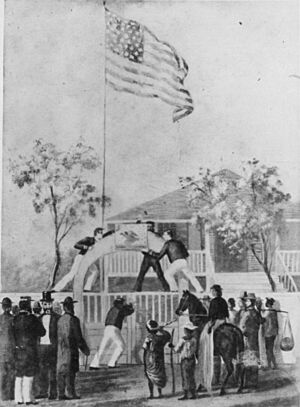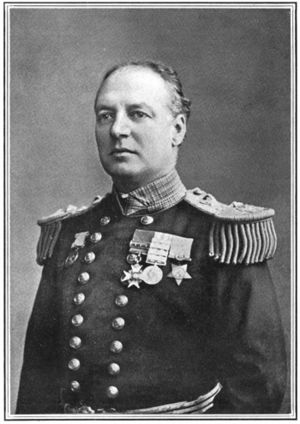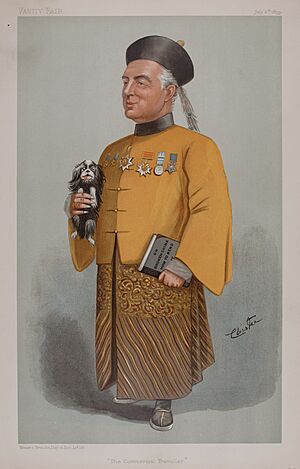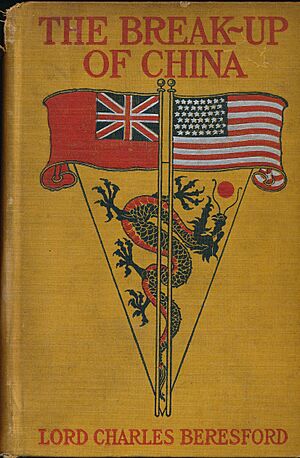Lord Charles Beresford facts for kids
Quick facts for kids
The Lord Beresford
|
|
|---|---|
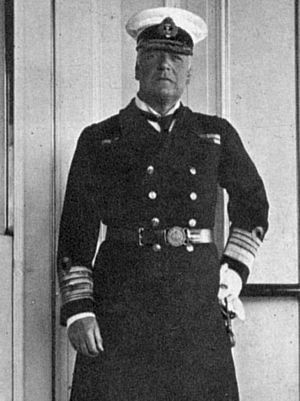
Beresford, as pictured in Queen Alexandra's Christmas Gift Book, distributed for charity
|
|
| Personal details | |
| Born | 10 February 1846 Curraghmore, County Waterford, Ireland |
| Died | 6 September 1919 (aged 73) Berriedale, Caithness, Scotland |
| Political party | Conservative |
| Spouse | Ellen Jeromina Gardner |
| Awards | Knight Grand Cross of the Order of the Bath Knight Grand Cross of the Royal Victorian Order |
| Signature |  |
| Military service | |
| Allegiance | United Kingdom |
| Branch/service | Royal Navy |
| Years of service | 1859–1911 |
| Rank | Admiral |
| Commands | |
| Battles/wars | Urabi Revolt Gordon Relief Expedition |
Admiral Charles William de la Poer Beresford, 1st Baron Beresford (born February 10, 1846 – died September 6, 1919) was a famous British admiral and a Member of Parliament. He was known to the public as "Charlie B".
Beresford was the second son in his family. He managed to have two careers at once: serving in the navy and being a politician. He became known as a hero in battles and a strong supporter of the navy in Parliament. He was a very popular person who liked to be in the public eye.
Later in his career, he had a long disagreement with another important admiral, Sir John Fisher. They disagreed about new technology and changes in the navy. Fisher was a bit older and more successful, which made it hard for Beresford to reach the very top position in the navy. Beresford commanded important fleets, like the Mediterranean and Channel fleets, but he never became the First Sea Lord, which was his biggest goal.
Contents
Early Life and Family
Charles Beresford was born in Philipstown, Ireland. He grew up in a large family with four brothers. His older brother, John, took over the family estate and titles. His brother William became a military secretary and won a special medal called the Victoria Cross. Marcus, another brother, worked for King George V and managed the King's racehorses. The youngest brother, Delaval, became a rancher in Canada.
His family had a long history in Ireland, dating back to English settlers. Their large estate in Curraghmore had stables for many horses and employed hundreds of people. The family loved hunting.
Beresford was known for being kind to his sailors. He believed in praising officers and men publicly when they did something good. Even when he was 46 and a captain, he joined in rowing competitions with his crew.
He married Ellen Jeromina Gardner on June 25, 1878, in London. They had two daughters, Eileen and Kathleen.
Charles Beresford was fascinated by ships from a young age. He joined the Royal Navy in 1859 when he was just 13 years old. He started his training at the naval academy HMS Britannia.
After his training, he served on several ships. He was on the flagship HMS Marlborough in the Mediterranean fleet. Later, he joined HMS Defence, one of the new ironclad warships. He then transferred to HMS Clio and became the senior midshipman.
In 1865, while on HMS Clio, Beresford and two other midshipmen played a prank in the Kingdom of Hawaii. They took a wooden American eagle sign from the United States legation. They were ordered to apologize and put the sign back. During this time, Beresford met Nancy Sumner, one of Queen Emma's ladies. They became friends and stayed in touch through letters.
Beresford continued his naval career, serving on ships like HMS Tribune and HMS Sutlej. He also took a gunnery course. In 1869, he sailed around the world on HMS Galatea, commanded by the Duke of Edinburgh.
Becoming a Member of Parliament
In 1874, Beresford became a Conservative Member of Parliament (MP) for County Waterford. He kept this job until 1880. It was unusual for a junior naval officer to speak about the navy in Parliament. The Prime Minister, Benjamin Disraeli, helped him keep his parliamentary seat. While an MP, Beresford continued to serve in the navy and became a commander in 1875.
In 1874, Beresford was chosen to join the Prince of Wales (who later became King Edward VII) on a trip to India. He was an aide to the Prince of Wales from 1875 to 1876. During this trip, the Prince insisted on dressing formally even in the jungle. They even cut the tails off their evening coats, which led to the creation of the dinner jacket.
Service in Egypt and Sudan
From 1878 to 1881, Beresford was second in command of the royal yacht HMY Osborne. In 1882, he was captain of the gunboat HMS Condor. His ship helped bombard Alexandria during the Egyptian war. He was praised for bringing his ship close to the Egyptian defenses.

In 1884 and 1885, Beresford joined the Gordon Relief Expedition in Sudan. He brought a new type of machine gun called a Gardner gun. During the battle of Abu Klea, his gun jammed, and he narrowly escaped danger.
Return to Parliament and Promotions
In 1885, Beresford was elected to Parliament again, representing Marylebone East. He strongly argued for more money to be spent on the navy. He even resigned from his seat in 1889 to protest this issue. His actions helped lead to the Naval Defence Act 1889, which increased naval spending.
Beresford believed in encouraging physical activity. He helped start the National Physical Recreation Society in 1886. He also suggested that local councils should provide gyms for people.
From 1889 to 1893, he was the captain of HMS Undaunted, which was part of the Mediterranean Fleet.
In 1898, Beresford was promoted to rear-admiral and entered Parliament again, this time for York. He spent a lot of time in China, representing British businesses. After returning, he wrote a book called The Break-Up of China (1899).
In 1900, he left Parliament to become second in command of the Mediterranean Fleet. Here, his dislike for Admiral Sir John Fisher grew. Beresford felt Fisher was a social climber, while Fisher was jealous of Beresford's wealth and social standing.
As an Admiral
Beresford was elected to Parliament again in 1902, representing Woolwich. He was promoted to vice-admiral in 1902. In 1903, he left Parliament to command the Channel Fleet. He was knighted and received high honors.
From 1905 to 1907, Beresford commanded the Mediterranean Fleet. An officer serving under him noted that Beresford's command focused on strict training. Beresford wanted to become the navy's top officer, the First Sea Lord, but Fisher held that position. Fisher was very respected and was allowed to stay in his role longer than usual. Beresford began a campaign to criticize Fisher's leadership, hoping Fisher would have to resign.
Beresford then commanded the Channel Fleet from 1907 to 1909. He was praised as an excellent seaman. He also suggested using Grimsby trawlers for minesweeping operations. This idea was used during the First World War, with fishing boats and their crews helping the navy.
Some historians believe Beresford's personality changed around this time, possibly due to a minor stroke. He had disagreements with Admiral Percy Scott. In one incident, Scott sent a sarcastic message about painting ships instead of practicing gunnery. Beresford was very angry and tried to have Scott removed from his command, but the Admiralty did not agree.
After his time with the Channel Fleet, Beresford returned to Parliament in 1910, representing Portsmouth. He continued to criticize the navy's policies, especially Fisher's reforms. This led to an investigation, and Fisher eventually retired early in 1910.
In 1912, King George V suggested Beresford be promoted to admiral of the fleet, but it didn't happen. Beresford was appointed an Honorary Colonel in the Royal Marines in 1914. While he supported some reforms, he was somewhat behind on the latest naval technology by the end of his service.
Beresford remained an MP until 1916. In January 1916, he retired from Parliament and was given the title Baron Beresford. In 1910, he became the Chief Sea Scout for The Boy Scouts Association and helped create their training program.
Death and Funeral
Lord Beresford died in 1919 at the age of 73. His title ended with his death. After a special funeral at St Paul's Cathedral, he was buried in Putney Vale Cemetery in London.
Awards and Honors
Besides his title, Lord Beresford received several honors from other countries:
- Grand Cordon of the Order of the Medjidie from the Ottoman Empire.
- Grand Cross of the Order of the Red Eagle from Prussia.
- Grand Cross of the Order of the Redeemer from Greece.
- Grand Cross of the Order of St Olav from Norway.
- Grand Cross of the Legion of Honour from France.
Images for kids


